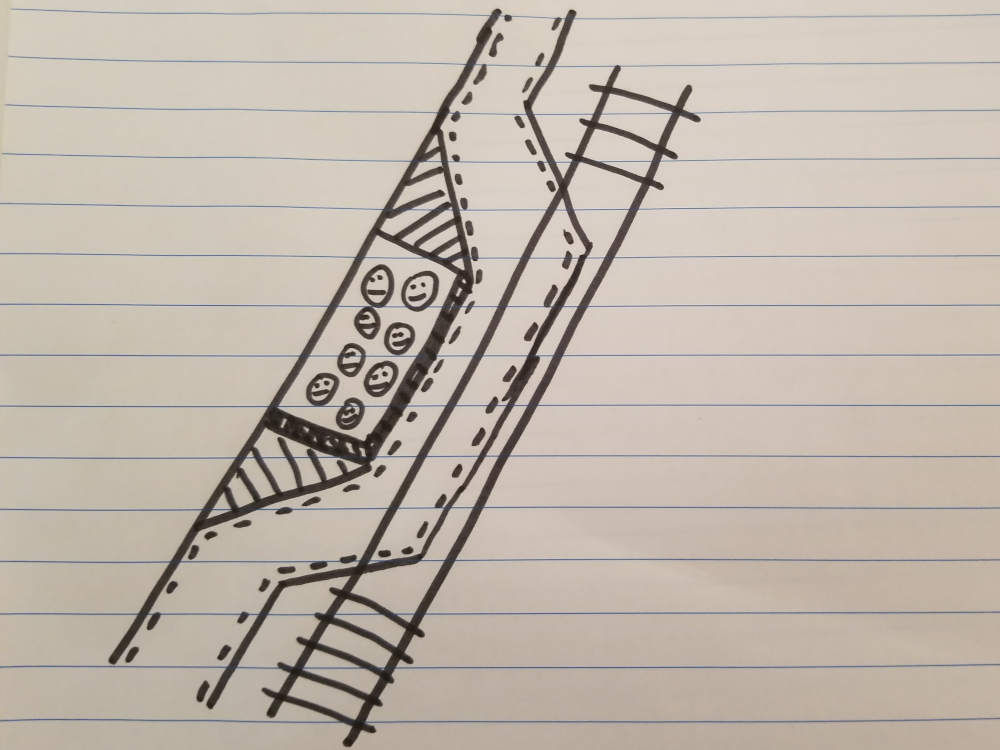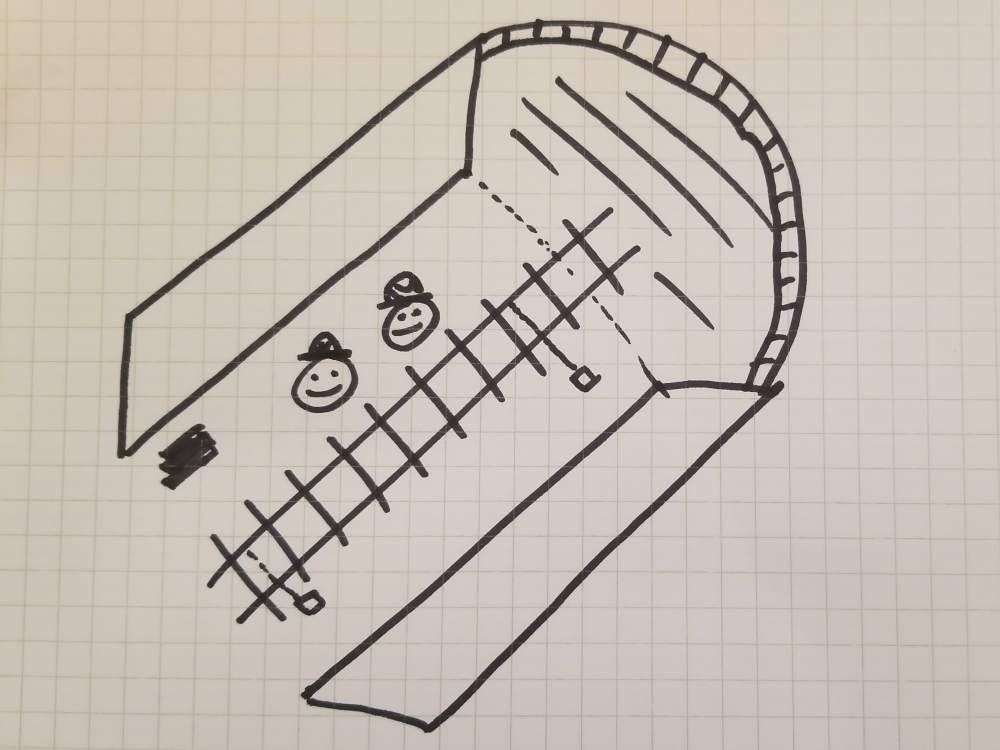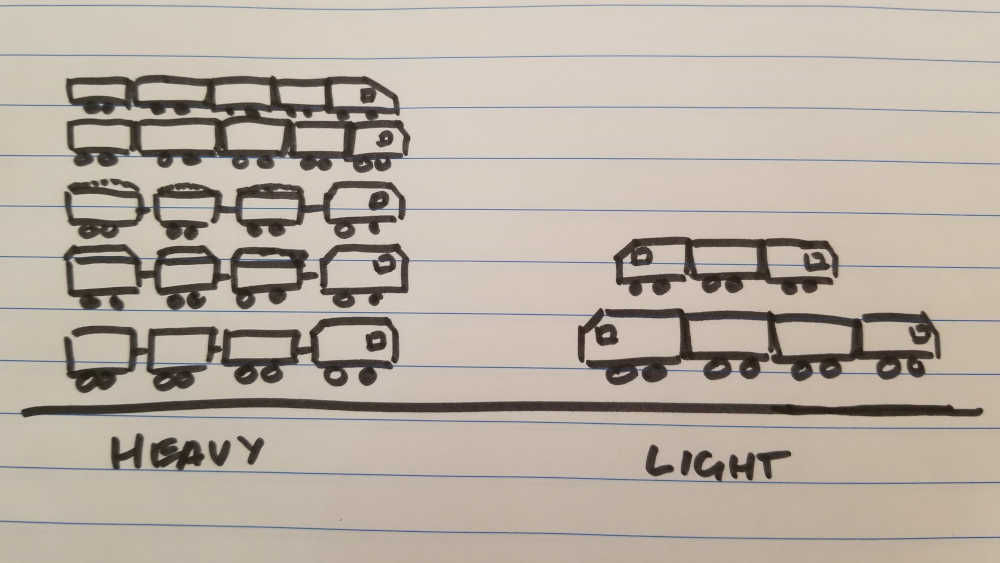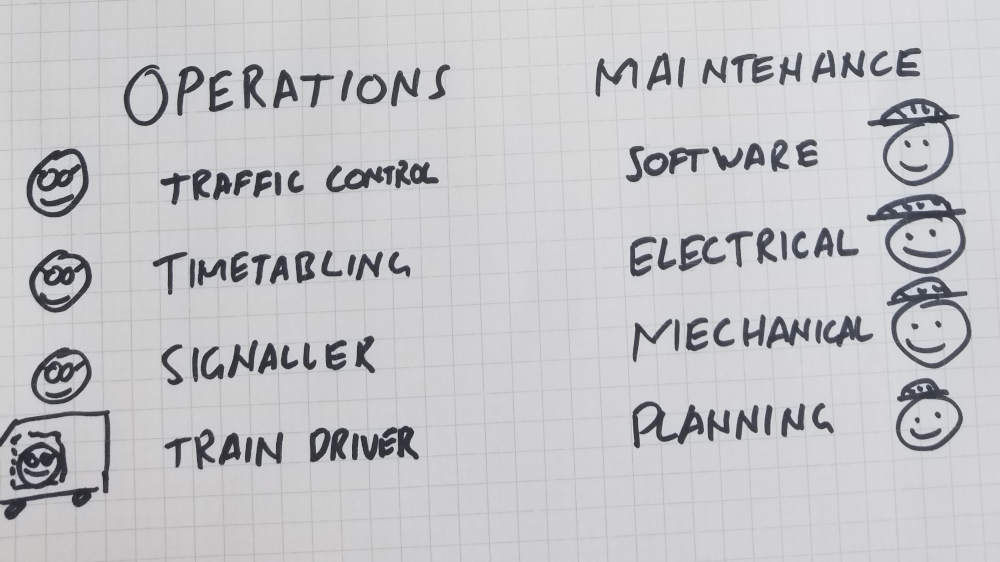Heavy Armored Fighting Vehicle Carrying Guns and Moving on a Continuous Articulated Metal Track
Heavy Rail and Light Rail, the difference explained with pictures
![]()
The differences between heavy rail and light rail are:
- the distance it takes to stop in an emergency, everything else stems from this;
- whether the rail lines are reserved only for the train, or if the lines are shared with other vehicles; and
- how much load the rail vehicle can carry.
 Light rail vehicles share the road, this makes it easier for passengers to get on board
Light rail vehicles share the road, this makes it easier for passengers to get on board
In my experience, these are the key differences between heavy rail and light rail. Every city I've been to likes to use their own terminology with their own unique history. I've summarised here my experience of how heavy rail and light rail can be used.
What is heavy rail
Heavy rail is a term used to refer to trains which:
- have their own dedicated space to avoid interacting with other traffic;
- take a long time to stop in an emergency; and
- carry heavy loads.
What is light rail
Light rail is a term used to refer to trains which:
- share their space with other traffic, such as cars;
- can relatively quickly stop in an emergency, generally travelling at slower speeds; and
- carry light loads, such as passengers in smaller carriages.
What are the differences between heavy rail and light rail?
Reserved or shared corridor
Light rail systems typically share their corridors with other vehicles.
 Light rail vehicles can share the road with cars, this makes them easier to access for passengers
Light rail vehicles can share the road with cars, this makes them easier to access for passengers
Some light rail systems, such as street cars or trams, have concrete filled in between the rails. This lets cars drive on the rails.
This is safe because the light rail vehicle can stop quickly if a car is in the way. Light rail vehicles can stop quickly enough to often avoid fatality, this does not mean the car survives however.
Driving on the street means that light rail passengers do not need to climb stairs to reach a platform. It also helps passengers see where the train is, and where it's going.
This good passenger experience makes light rail popular.
Heavy rail systems operate in their own corridor, segregated from other vehicles. This allows them to travel at speed without the concern that something will get in their way. It also allows more control over the positioning of trains such that those trains avoid collision - this means more trains safely running on the line.
 A heavy rail corridor is separated from other traffic. Authorised personnel only.
A heavy rail corridor is separated from other traffic. Authorised personnel only.
Stopping distance
Heavy rail trains take a long distance to stop:
- Passenger trains which stop regularly at platforms take roughly 160m/525ft to stop
- Freight trains with heavy loads can take over 2km/1.25miles to stop
Light rail trains can stop to avoid a pedestrian that steps out in front of them. Watch out though, this is only because light rail trains travel slowly. In some areas they travel fast enough that a pedestrian stepping out in front of the train won't end well for the pedestrian.
How much the vehicle can carry
 Heavy rail can support more trains, longer trains, and heavier trains such as freight
Heavy rail can support more trains, longer trains, and heavier trains such as freight
This is the namesake for heavy and light rail.
Light rail vehicles carry lighter loads than heavy rail vehicles.
Light rail vehicles typically only carry passengers. The carriages on light rail vehicles are also smaller, and trains consist of fewer carriages. This limits the number of passengers light rail vehicles carry.
Light rail vehicles must be light to allow them to stop quickly.
Heavy rail vehicles carry passengers, luggage, cargo, freight and do not have as many limits on their size or weight.
Heavy rail vehicles do not have to stop quickly, and are allowed to weigh more.
What are the differences in controlling light and heavy rail
 Heavy rail trains are controlled with signals, light rail trains are controlled with traffic lights
Heavy rail trains are controlled with signals, light rail trains are controlled with traffic lights
Light rail trains are typically controlled using traffic lights.
I like to think of light rail vehicles as busses on fixed routes: The control centre cannot control the bus directly, but can speak to the bus driver about where to go and what the bus is currently doing. Light rail vehicles are often treated the same.
Heavy rail trains are typically controlled using signalling.
Train control signalling is the system by which trains are told when to go and when to stop to avoid colliding with other trains.
Heavy rail vehicles take so long to stop, drivers cannot see the vehicle in front of them. Signalling is used to tell the driver whether or not there is a train ahead.
I wrote recently about what signalling is with a picture guide to the more important features of signalling. Check it out here: https://econstructioncareers.com/news-insight/rail-signalling
What are the differences in powering light and heavy rail
Overhead electricity lines are popular for powering both light rail and heavy rail. Having the lines overhead reduces the chance that people will be electrocuted.
 Overhead wiring can stretch across a street; third rail sits by the side of the running rails
Overhead wiring can stretch across a street; third rail sits by the side of the running rails
Some light rail systems draw their power from the ground, such as the new Sydney Light Rail. The electricity is turned on only to the area underneath the light rail vehicle to avoid people being electrocuted.
Light rail systems can also implement batteries on the vehicle. The frequent stopping provides an opportunity to recharge batteries as the vehicle travels its route.
Heavy rail vehicles can use overhead wiring, third rail, or diesel for power.
What are the differences in jobs?
 Most rail jobs are in Operations and Maintenance
Most rail jobs are in Operations and Maintenance
Heavy rail lines are more complicated. They employ more operations staff to control the lines.
Heavy rail trains also have greater wear on the lines, and need more maintenance staff to look after the lines.
Light rail trains don't need as many operations and maintenance staff, except for drivers. I cannot think of a single self-driving light rail. Light rail drivers are still an in demand job.
Maintaining the overhead power supply, the tracks, the vehicles themselves is mostly the same between heavy and light rail: The same parts need regular treatment, repair, and overhaul.
Maintaining the train control system is a little different though. If two heavy rail trains collide, it can be devastating; heavy rail signalling needs extra care to prevent this. Light rail vehicles follow rules like buses, they can still operate safely without their traffic control system.
Heavy rail and light rail are terms used to distinguish characteristics of a train, such as its ability to stop and carry loads.
There is no standard on what light and heavy mean. It's up to the city, the project, and the people in charge to figure out whether they're going to call their transport system light or heavy.
Related:
- An explanation of some of the terms, such as corridor, that we use can be found here: https://econstructioncareers.com/news-insight/eleven-rail-terms
- An overview of train control signalling I put together can be found here: https://econstructioncareers.com/news-insight/rail-signalling
Source: https://econstructioncareers.com/news-insight/heavy-light-rail-difference
0 Response to "Heavy Armored Fighting Vehicle Carrying Guns and Moving on a Continuous Articulated Metal Track"
Post a Comment